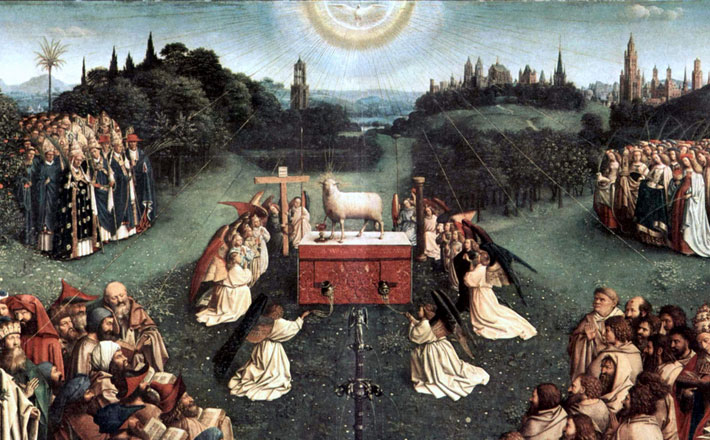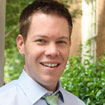Commentary on Revelation 7:9-17
Each year around All Saints Sunday, I’m reminded of Lawrence Hull Stookey’s writing about this Feast Day.
Stookey tells the story of a friend of his who explained to a Protestant class about the meaning of All Saints Day. A student abruptly stood up and replied, “Protestants don’t have saints!” The professor, in a moment of quick wit, ran to his office to grab a phonebook, and he asked the student to read the names of all the churches in the area. The student read, “St. James Baptist Church, St. John’s Lutheran Church, John Knox Presbyterian Church,” until he gave up and said, “I get it … I’m wrong!”
It became obvious to that student, and to the whole class, that we all have saints — those who are deceased, and those who are living and walking among us, and if we think with Paul, perhaps even we ourselves are saints. The word saint is not limited to the “greats” of history, for Paul and other writers in the New Testament use the term synonymously with Christian and, at times, believer. No matter how you define it, the word saint has broad implications, and that is perhaps the best way to describe this week’s New Testament passage from Revelation 7.
Revelation 7:9-17 is a passage with broad implications. In contrast to the first eight verses in this chapter which depict a specific number of worshipers (144,000), Revelation 7:9 casts a larger and more general vision for those who are able to worship around the throne of the Lamb. Beginning with verse 9, the writer describes a great multitude that is countless, numbering those from every tribe and people, and language. There is no limit to the scope of this multitude, be it geographic, ethnic, numeric, linguistic, economic, and on and on the list goes. This multitude is a blow-your-mind kind of multitude that no one can fully grasp. (verses 9-10).
Moreover, this multitude is seen and heard(verse 9). The multitude is clad in white, it is waving palm branches, and it is crying hymns of praise in a loud voice. While much of this imagery parallels the Triumphal Entry scene as depicted in the gospels, it should be noted that this multitude certifiably pledges itself to the Lamb. Unlike the multitude in the Triumphal Entry scene that later turns its back on the Messiah, this multitude will remain faithful to the Lamb “forever and ever.”1
Not only is this particular multitude to be known for its loyalty, this multitude is to be known as an active group. This group is comprised of individuals who have washed their robes. They are not passive, but active. They do not wait to be served by God, but they actively seek to serve God regularly. It is John who paints a clear picture of this group living out their vocation of worship and praise.
When asked by one in power, John describes not only their current actions but the results of their actions. They remain loyal to the Lamb, they wash their robes, and they worship in the temple (verses 13-15). As a result, they are sheltered, they are fed, they are quenched, they are protected (verses 15-17). Summed up, it might be said that this multitude has found freedom in the One they worship. Herein, the prophecy of Isaiah 25 is fulfilled.
On this Feast Day of All Saints, we Christians around the world gather to celebrate the lives of those saints who have gone on before us. We give thanks for those saints living still today. And, we ponder how all of us — you and me — are called to live lives of sanctity. This passage reminds us that being a faithful witness — like the great multitude — is the baptismal vocation of us all. It also reminds us that when we live out our Christian vocation, we find freedom in the Lamb of God who sustains all of us.
Most importantly, this passage reminds us that the vision for sainthood is all encompassing. It is all-inclusive. And, this needs to be the heart of any sermon preached on All Saints Sunday. The “great multitude” might include those who “washed their robes by living lives worthy of standing around the throne of God, but never named the name of Jesus.
Herein, this apocalyptic text, along with All Saints, reminds us that Christianity and saint-hood can’t always be reduced to a theological formula. Indeed, it was Jesus who said, “Not everyone who says to me, ‘Lord, Lord,’ will enter the kingdom of heaven, but only the one who does the will of my Father in heaven” (Matthew 7:21).
It is this truth, when coupled with the final verses of this passage, that we are reminded sanctity is partially Christian vocation, but it is also partially the work of God. Sanctity doesn’t come from us, it comes from the Lamb in whose name, person, and earthly vocation we are made free to approach the throne with boldness. It is here that once again, Lawrence Hull Stookey’s perspective becomes helpful:
“…those we rightly revere are ‘God’s saints’ in the sense that God creates them by grace. Men and women do not by sheer determination and self-discipline become saints. Sanctity is a divine gift. It is indeed the power of the resurrection at work in human lives. Thus commemorating the saints is nothing other than a way of affirming that the transformative power of Christ is at work all about us in human lives…We are saints because God’s sanctity is at work in us, not because on our own we have come to great spiritual attainment. In exploring the lives of the historic saints, it is necessary to be thoroughly honest about their limitations and faults, for only in this way do we come to believe that God can also work in the people around us and even in us, whose faults we know fully well.”2
Notes:
1 Christopher C. Rowland, “The Book of Revelation: Introduction, Commentary, and Reflections,” in The New Interpreter’s Bible: Volume XII, ed. Leander E. Keck, Thomas G. Long, David L. Petersen, et al, The New Interpreter’s Bible: A Commentary in Twelve Volumes (Nashville, TN: Abingdon Press, 1994), 621.
2 Lawrence Hull Stookey, Calendar: Christ’s Time for the Church (Nashville, TN: Abingdon Press, 1996), 141-142.


November 2, 2014